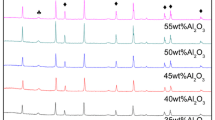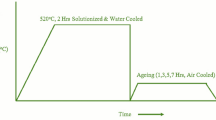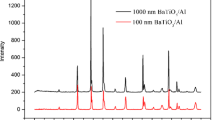Abstract
The presence of h-BN phase in the composites, in which it is fulfilling a role of a solid lubricant, causes the appearance of the anisotropy of the elastic properties and thermal properties. In order to assess the extent of the phenomenon, velocity changes of ultrasonic wave propagation were measured and thermal conductivity changes were researched. Measurements were carried out on composites of alumina matrix, which had h-BN introduced in an amount of 0–30 vol.%. The study included measurements of the speed of propagation of ultrasound waves and thermal conductivity, which were made in two directions, namely, perpendicular and parallel directions to the axis of compression. Strong dependence of the thermal conductivity anisotropy of the phase composition of materials was revealed.
Similar content being viewed by others
Avoid common mistakes on your manuscript.
Introduction
Polycrystalline alumina materials have good mechanical properties, temperature stability of mechanical properties, and resistance to corrosion and erosion [1–3]. Beneficial physicochemical and mechanical properties of alumina materials in combination with the relatively low price of the raw material determine the wide range of use in technology of elements made of aluminum oxide ranging from electronics through the elements of the apparatus to the ballistic shield [4, 5]. Alumina is also used for the manufacturing of cutting inserts for the machining of metals.
The development of cutting technology progresses to increase cutting speed and to eliminate machining coolants, so materials that are used for cutting are confronted with increasingly stringent quality requirements. The increase in cutting speed results in increased heat generation in the cutting zone and the elimination of the cooling liquids worsens the heat dissipation. This exposes cutting tool material to excessive heat and loss of rigidity. Studies on the alumina materials’ properties adaptation to new operating conditions are aimed at improving the mechanical properties and reducing the amount of heat generated during cutting. The first route leads to the formation of particulate composites in which alumina matrix is reinforced with dispersed phases, such as molybdenum, Nowotny phase (MAX phase), or zirconium boride phases [6, 7]. To increase the toughness of the alumina matrix, the ZrO2 is commonly used [8]. The hard phases such as TiB2, TiN, or TiC are introduced to the Al2O3 matrix in order to improve hardness, toughness, and wear resistance of the material [9, 10]. The second direction aims to reduce an amount of heat generated during machining by reducing the coefficient of friction of the cutting tool and workpiece chip. This intention can be achieved by introducing the microstructure of the material particles able to act as a solid lubricant. Such role can be fulfilled by hexagonal boron nitride [11] or CaF2, which is used in the alumina composited reinforced by transition metals’ borides, nitrides, or carbides [12–14]. Lubricants such as hexagonal boron nitride were positively used in case of boron carbide-based composites [15]. The authors noticed a decreased friction coefficient of the sample working with and without cooling agent. Also, there are some works on introducing h-BN to the Si3N4 [16] which showed that the friction is strongly decreased during machining process as a result of the reaction of h-BN with water.
When the temperature at the tip of cutting tool reaches ca. 900 °C, the acid is formed [17]:
In the literature, some works made on hot-pressed alumina—hexagonal BN materials starting in an addition not exceeding 10 vol.%—can be found [18]. Very good machinability of Al2O3/h-BN composites was observed by Li et al. [19], in case of samples containing h-BN introduced by chemical method and hot-pressed at 1,600–1,800 °C. No data concerning correlation between anisotropy of thermal and elastic properties and manufacturing method of this kind of material were found in the literature.
In view of the plate shape of the h-BN particles, in the wafer processing technology using hot uniaxial pressing technique (hot-pressing), there is a danger of the privileged orientation of the boron nitride grains in the microstructure of the material and the appearance of anisotropy of mechanical properties and thermal properties. For this reason, it was necessary to perform measurements enabling assessment of the range of the expected changes.
Materials and methods
For the preparation of composite materials in the Al2O3/h-BN system, the following commercial powders were used: submicron alumina (0.1 μm, manufacture analysis) Taimicron TM-DAR from Taimei CHEMICALS CO., LTD. and submicron (0.3–0.7 μm, manufacture analysis) hexagonal boron nitride BO-501 from Atlantic Equipment Engineers. The powders were prepared in mass proportions in such a way that the mixture contained 0, 0.5, 1, 2, 5, 10, 20, and 30 vol.% boron nitride. Prepared systems were subjected to homogenization in the rotary vibrating mill. Homogenization step was carried out in an isopropyl alcohol for 6 h at 80 % of the mill chamber filled with alumina grinders in order to mill boron nitride agglomerates. After drying and granulating the resulting powder mixture, obtained material was then sintered using a hot-pressuring device of Thermal Technology Inc. The sintering process was conducted in a graphite mold with graphite punches adopted to uniaxial pressing. The hot-pressing was made in an argon flow under a pressure of 25 MPa at a heating rate of 10 °C min−1 to a final temperature of 1400 °C, then the annealing process was carried out for 60 min. There were obtained sintered discs with a thickness of 6 mm and a diameter of 75 mm.
Apparent density measurements were made with the use of hydrostatic method. Related density was calculated.
Velocity measurements of elastic wave propagation in sinters were obtained in the perpendicular and parallel directions to the axis of compression with the ultrasonic apparatus PPO-1 (INCO-VERITAS) transducers for longitudinal waves f = 10 MHz, and transducers for transverse waves f = 4 MHz. Following equations were used to calculate elastic properties:
where E is the young’s modulus [GPa], G is the shear modulus [GPa], μ is the poisson ratio, ρ is the sample’s apparent density [g cm−3], v L is the longitudinal wave velocity [m s−1], and v T is the transverse wave velocity [m s−1].
Specific heat measurements were performed on a thermal analyzer Netzsch STA 449 F3, by using calculation signals from differential scanning calorimetry of the tested material and sapphire. Thermal diffusivity values were obtained using a laser pulse method on the device Netzsch LFA 427. The thermal conductivity was calculated by
where a(T) is the thermal diffusivity [mm2 s−1], c p(T) is the specific heat capacity [J g K−1], and ρ(T) is the material apparent density [g cm−3], calculated from hydrostatic measurements.
Observation of the microstructure of the mechanically polished and surfaces of sinters was performed using scanning electron microscopy on the device’s NOVA NANO SEM by FEI.
Results and discussion
The apparent density measurements by hydrostatic method were taken into relative density calculations. The results are illustrated in Fig. 1.
The samples containing up to 10 vol.% of the introduced h-BN show densification higher than 98 %. For higher quantities of additive, the part of h-BN could be removed out of the sample surface during mechanical treatment causing error in open porosity measurements for samples with higher additive content. The closed porosity can be related to large agglomerates of h-BN as the effect of not well-packed additive plates.
Microscopic observation of polished specimens allows to conclude that the h-BN grains are uniformly dispersed in the microstructure of the composite, but defects in the form of mechanical etchings, soft boron nitride phase, do not allow the quantitative analysis of the microstructures. Sample images of the microstructure are shown in Figs. 2, 3, and 4.
Figures 2 and 3 show that h-BN particles are orientated but there are also some agglomerates with non-oriented h-BN plates and possible internal porosity inside agglomerates related to plates packing. It can have significant influence on anisotropy and value of thermal properties and it is a cause of higher porosity of composites containing very high quantity of the introduced h-BN.
The results of ultrasonic measurements, carried out on the materials with different amount of h-BN phases, showed an increase in damping and a decrease in elastic wave propagation velocity with the increase of volume fraction of hexagonal boron nitride dispersed in Al2O3 matrix. Also, there was an increase of ultrasonic velocity anisotropy with increasing volume fraction of h-BN. The results of measurements of ultrasonic wave velocity and its anisotropy are illustrated in Figs. 5 and 6. The changes in elastic properties are shown in Fig. 7.
Finding a strong anisotropy of the velocity of ultrasonic waves, therefore also the anisotropy of the elastic properties, which may be caused by a privileged orientation of hexagonal platelets of boron nitride grains in the microstructure of sinters, suggests the possibility of anisotropic thermal conductivity of composites. The decrease in Young modulus can also be linked with low E modulus of increasing content of h-BN. For hot-pressed hexagonal boron nitride, the elastic modulus is 41–97 GPa for parallel direction and 41–103 GPa for perpendicular direction to pressing axis [20]. In accordance with density and microstructure measurements, the large anisotropy can also be caused by the existence of h-BN agglomerates and the porosity. This suggestion was confirmed by the results of measurements of thermal conductivity coefficient changes made in the composites examined at room temperature. The measurement results of thermal conductivity changes caused by the changes in the volume fraction of h-BN are shown in Fig. 8.
Decrease in thermal conductivity with an increase in fraction of the dispersed phase confirms the hypothesis about h-BN grain orientation as the isotropic thermal conductivity of sintered Al2O3 is about 35 W mK−1, and the coefficients of thermal conductivity of h-BN are anisotropic. Towards a “c” crystallographic direction, thermal conductivity of h-BN has a value of 1.5–2.9 W mK−1 while in the “a” crystallographic direction the value is 62 W mK−1 [20], thus the reduction in the thermal conductivity of composites should be attributed to orientation of the boron nitride plate grains. The porosity begins to play a significant role in the case of materials of higher (>10 %) h-BN content. The nature of changes in the value of thermal conductivity confirms a significant effect of the h-BN presence on the thermal conductivity of composites. In order to reveal the extent of the conductivity changes, thermal conductivity changes in the temperature range relevant for the intended use of materials were measured. Results of the measurements are illustrated in Figs. 9 and 10.
The introduction of hexagonal boron nitride leads to the reduction of thermal conductivity of composites in comparison to pure polycrystalline alumina (Figs. 8, 9). The addition of solid lubricant strongly decreases the thermal conductivity at higher temperatures. It starts when 2 vol.% of h-BN is exceeded (Fig. 9). It can mainly be explained by an increase of anharmonic vibrations versus increasing additive content.
The thermal diffusivity obtained directly from the measurement, which is a component of thermal conductivity, has very small error, which indicates high phase stability of manufactured composites at elevated temperatures. The used laser method to determine thermal properties is very sensitive to the thermal stability of the material.
Studies of anisotropy of thermal conductivity were carried out on materials with the highest amount of h-BN phase (Fig. 10). Measurements were made in the parallel and perpendicular directions to the direction of the force (pressing axis). The calculated thermal conductivity anisotropy is shown in Fig. 11.
The results of measurements indicate the presence of a strong anisotropy of the thermal conductivity of the composites, which decreases with increasing temperature for 30 vol.% content of the introduced h-BN (Fig. 11), where the observed content of additive agglomerates is increasing (Fig. 4). Inside the agglomerates, there is no special orientation of hexagonal BN plates (Fig. 3). For 20 vol.% of h-BN, anisotropy is still increasing as a result of lower agglomerate content so higher concentration of orientated h-BN plates. The existence of h-BN agglomerates is a problem for homogenization conditions. The high-energy rotary-vibratory mill was used to provide one of the best homogenization methods for powder mixture preparation. The high rate of milling agent and longer (at least 5 h) process time [21] are needed in order to grind and remove the h-BN agglomerates. It has a significant influence on mechanical properties, which are improved when the agglomerates are destroyed [21]. In addition, Broniszewski et al. [18] used an attritor-type mill for homogenization, which resulted with good deagglomeration effect for small solid lubricate content (as in the case of this study), but they did not mentioned about h-BN quantities higher than 10 vol.%. Cho et al. [22] noticed the formation of high porosity BN pockets in sintered bodies of AlN-hBN composites, where the starting powders were mixed with the use of simple ball milling method. They connected this effect for example with significant decrease of bending strength for higher h-BN content. Li et al. [19] noticed very good homogeneity of Al2O3 with high h-BN concentration in the case where the nano-sized hexagonal BN was prepared by chemical process using boric acid.
Conclusions
-
1.
The use of hot-pressing technique for manufacturing the alumina matrix composites with the dispersed phase of hexagonal boron nitride material results in a strong anisotropy of the elastic and thermal properties in obtained materials.
-
2.
The presence of hexagonal boron nitride leads to a strong anisotropy of the composites produced by hot-pressing.
-
3.
The anisotropy of composites with high (30 vol.%) boron nitride concentration reaches even 40 % for the elastic and thermal properties.
-
4.
Probable cause of anisotropy is oriented distribution of plate h-BN grains in the microstructure of sinter. For higher additive quantities, the agglomerates and porosity play an important role.
-
5.
Laser pulse method allows to determine the thermal properties anisotropy of the manufactured materials.
References
Kumar AS, Durai AR, Sornajumar T. Machinability of hardened steel using alumina based ceramic cutting tools. Int J Refract Met Hard Mater. 2003;21:109–17.
Liu ZQ, AI X. Cutting tool materials for high speed machining. Prog Nat Sci. 2005;14:777–83.
Galusek D, Twigg PC, Riley FL. Wet erosion of liquid phase sintered alumina. Wear. 1999;233–235:588–95.
Übeyli M, Yildirim RO, Ögel B. Investigation on the ballistic behavior of Al2O3/Al2O24 laminated ceramics. J Mater Process Tech. 2008;196:356–64.
Edler F. Material problems in using high-temperature thermocouples. Int J Thermophys. 2011;32:1418–28.
Kathryn Vance Logan, Development of Al2O3–TiB2 composite materials for cutting tool application, Georgia Tech Research Institute, Georgia Institute of Technology, 1986.
Bin Li, Deng Jianxin, Wu Ze. Effect of cutting atmosphere on dry machining performance with Al2O3/ZrB2/ZrO2 ceramic tool. Int J Adv Manuf Tech. 2010;49:459–67.
Zhao Z, Zhang L, Song Y, Wang W, Jiang W. Microstructure and properties of rapidly solidified Y2O3 doped Al2O3/ZrO2 composites prepared by combustion synthesis. Scripta Mater. 2006;56:819–22.
Deng J, Zhang H, Wu Z, Lian Y, Xin Y, Li S. Unlubricated friction and wear bahaviour of Al2O3/TiC ceramic cutting tool materials from high temperature tribological tests. Int J Refract Met Hard Mater. 2012;35:17–26.
Rabiezadeh A, Ataie A. Sintering of Al2O3–TiB2 nano-composite derived from milling assisted sol-gel method. Int J Refract Met Hard Mater. 2012;33:58–64.
Saito T, Imada Y, Honda F. Chemical influence on wear of Si3N4 and hBN in water. Wear. 1999;236:153–8.
Deng J, Cao T, Yang X, Liu J. Self-lubrication of sintered ceramic with CaF2 additions in dry cutting. Int J Mach Tools Manuf. 2006;24:957–63.
Deng J, Can T, Sun J. Microstructure and mechanical properties of hot-pressed Al2O3/TiC ceramic composites with the additions of solid lubricants. Ceram Int. 2005;31:249–56.
Deng J, Cao T, Yang X, Liu J, Sun J, Zhao J. Wear behavior and self tribofilm formation of hot-pressed Al2O3/TiC/CaF2 ceramic composites sliding against cemented carbide. Ceram Int. 2007;33:213–20.
Jiang T, Jin Z, Yang J, Qiao G. Investigation on the preparation and machinability of the B4C/BN nanocomposites by hot-pressing process. J Mater Process Technol. 2009;209:561–71.
Saito T, Hosoe T, Honda F. Chemical wear of sintered Si3N4, hBN and Si3N4–hBN composites by water lubrication. Wear. 2001;247:223–30.
Viricelle JP, Goursat P, Bahloul-Hourlier D. Oxidation behaviour of a boron carbide based material in dry and wet oxygen. J Therm Anal Calorim. 2001;63:507–15.
Broniszewski K, Woźniak J, Czechowski K, Orłowski P, Olszyna A. Properties of Al2O3–hBN composites. World Acad Sci Eng Techno. 2012;68:96–9.
Li YL, Qiao GJ, Jin ZH. Machinable Al2O3/BN composite ceramics with strong mechanical properties. Mat Res Bull. 2002;37:1401–9.
Engineering property data on selected ceramics, volume 1, nitrides, metals and ceramics information center, Columbus, Ohio 43201-2693, 1987.
Górny G, Pampuch R, Stobierski L, Rutkowski P. Ceramic tool materials for high speed cutting proces. Adv Sci Tech. 2010;65:56–60.
Cho WS, Piao ZH, Lee KJ, Yoo YC, Lee JH, Cho MW, Hong YC, Park K, Hwang WS. Microstructure and mechanical properties of AlN–hBN based machinable ceramics prepared by pressureless sintering. J Eur Cram Soc. 2007;27:1425–30.
Acknowledgments
This study was sponsored by the European Structural Fund in Poland on the basis of an agreement UDA-POIG.01.03-12-024/08-00 implemented by a scientific and industrial consortium. The results are part of a wider study the properties of a new generation of cutting tools in order to develop low-cost and environmentally friendly methods for the design of ceramic materials for high-speed cutting of difficult to machine materials. Thermal conductivity measurements were made in collaboration with the Faculty Laboratory of Thermophysical Measurements of Materials Science and Ceramics Faculty, AGH University of Science and Technology in Krakow.
Author information
Authors and Affiliations
Corresponding author
Rights and permissions
Open Access This article is distributed under the terms of the Creative Commons Attribution License which permits any use, distribution, and reproduction in any medium, provided the original author(s) and the source are credited.
About this article
Cite this article
Rutkowski, P., Piekarczyk, W., Stobierski, L. et al. Anisotropy of elastic properties and thermal conductivity of Al2O3/h-BN composites. J Therm Anal Calorim 115, 461–466 (2014). https://doi.org/10.1007/s10973-013-3246-5
Received:
Accepted:
Published:
Issue Date:
DOI: https://doi.org/10.1007/s10973-013-3246-5















